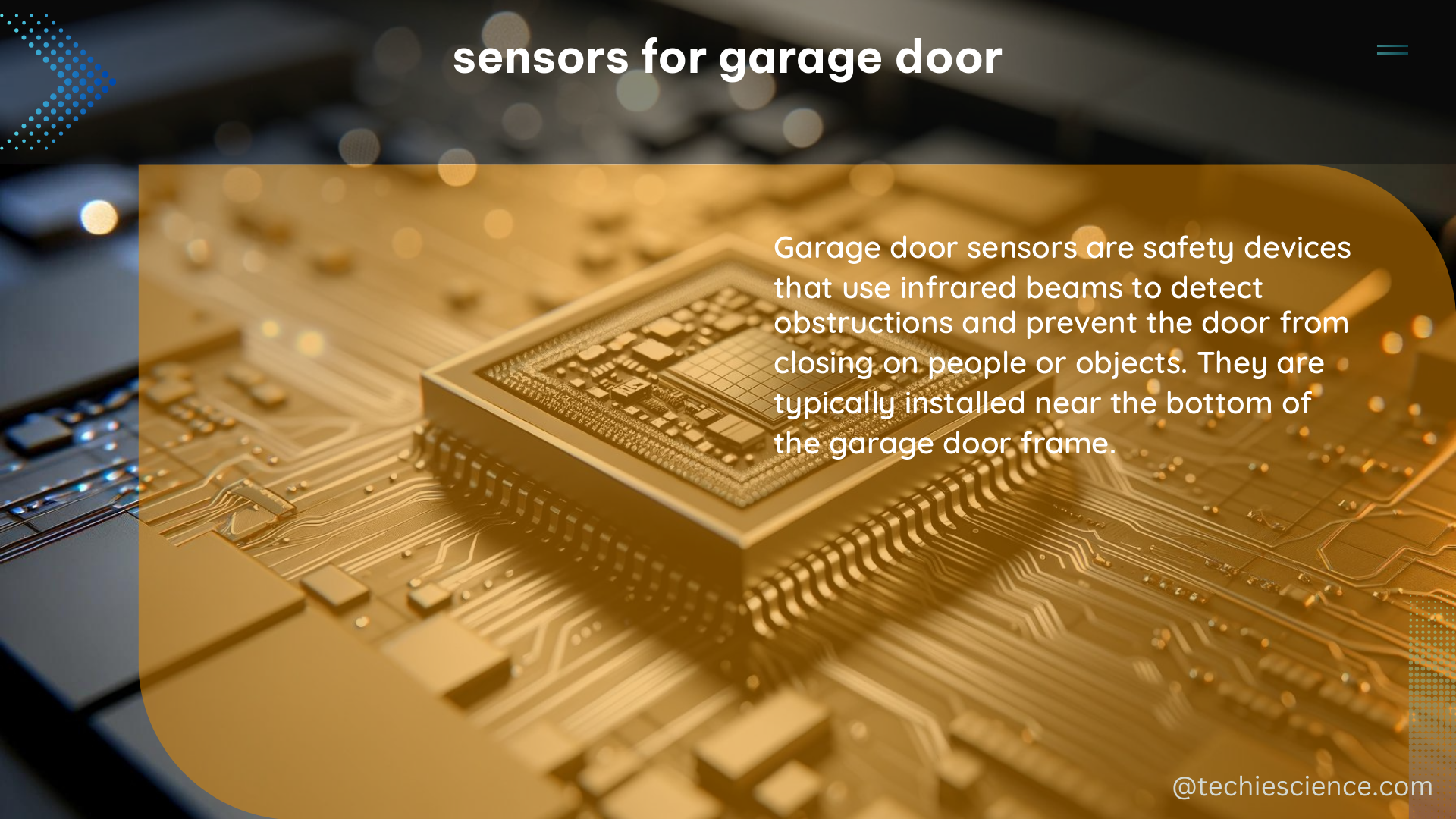Sensors for garage doors are essential components that ensure the safety and functionality of these essential home features. These sensors come in various types, including infrared, optical, and magnetic, each with its unique specifications and capabilities. Understanding the technical details and proper installation of these sensors is crucial for homeowners and DIY enthusiasts alike.
Infrared Sensors
Infrared sensors, commonly used in most garage door openers, emit beams of light that detect obstructions when the door is closing. These sensors typically consist of an emitter and a receiver, which must be aligned correctly for proper operation. Misaligned sensors may display error messages even when correctly positioned, and in such cases, resetting the start and endpoints of the garage door opener may resolve the issue.
The technical specifications of infrared sensors for garage doors include:
- Wavelength: Typically in the range of 850-950 nanometers (nm), with 940 nm being a common wavelength.
- Beam Angle: The angle of the emitted infrared beam, typically ranging from 10 to 30 degrees.
- Sensing Range: The maximum distance at which the sensor can reliably detect an obstruction, often between 4 to 40 feet (1.2 to 12 meters).
- Response Time: The time it takes for the sensor to detect an obstruction and signal the garage door opener, typically less than 50 milliseconds.
- Power Supply: Most infrared sensors for garage doors operate on low-voltage DC power, usually 12-24 VDC.
Optical Sensors

Optical sensors can be used to add an additional layer of safety to garage doors. These sensors can be connected in parallel with existing sensors or used to interrupt the primary beam loop, providing an extra measure of protection against accidents. The technical specifications of optical sensors for garage doors include:
- Sensor Type: Photoelectric, using either through-beam or retro-reflective technology.
- Sensing Range: Typically between 6 to 50 feet (1.8 to 15 meters) for through-beam sensors and 1 to 30 feet (0.3 to 9 meters) for retro-reflective sensors.
- Beam Diameter: The diameter of the optical beam, usually between 5 to 20 millimeters (mm).
- Response Time: Similar to infrared sensors, with a response time of less than 50 milliseconds.
- Power Supply: Optical sensors for garage doors often operate on 12-24 VDC, like their infrared counterparts.
Magnetic Sensors
Magnetic sensors, like the ones used in many garage door systems, typically consist of a magnet and a reed switch, which detect the presence or absence of the magnet. These sensors can be wired to an input on an alarm system or integrated with home automation systems like Home Assistant. The technical specifications of magnetic sensors for garage doors include:
- Sensor Type: Reed switch, which opens or closes a circuit when a magnetic field is detected.
- Sensing Range: Typically between 0.5 to 2 inches (12 to 50 millimeters) for the magnet-to-switch distance.
- Switch Rating: The maximum voltage and current the reed switch can handle, often in the range of 12-24 VDC and 0.5-1 Amp.
- Mounting: Magnetic sensors are usually mounted on the garage door and the door frame, with the magnet and reed switch aligned when the door is closed.
- Integration: Magnetic sensors can be easily integrated with smart home systems, providing real-time status updates on the door’s position.
Technical Specifications and Integration
When it comes to the technical specifications of sensors for garage doors, the SmartThings sensor in “garage door” mode is a good example. This sensor measures the extremes of the X/Y/Z values when the door is all the way up and all the way down, allowing for precise tracking of the door’s position. This is achieved by creating helpers that measure the door’s position and trigger automations based on the sensor’s data.
To optimize the performance and integration of sensors for garage doors, it’s essential to consider factors such as alignment, connection, and power supply. Proper installation and calibration of these sensors can ensure reliable operation and prevent issues like misalignment or false triggers.
In summary, sensors for garage doors are crucial for safety and functionality, and understanding their technical specifications is essential for homeowners and DIY enthusiasts. By familiarizing themselves with the different types of sensors, their capabilities, and the proper installation and integration methods, users can ensure the smooth and secure operation of their garage doors.
References:
– Misaligned Sensors but the Sensors are Aligned
– SmartThings Sensor Garage Door Mode with Home Assistant
– Garage Door Sensors
– Add Second Set of Sensors to Garage Door Opener
– Bypassing/Emulating Garage Door Opener Safety Sensors

The lambdageeks.com Core SME Team is a group of experienced subject matter experts from diverse scientific and technical fields including Physics, Chemistry, Technology,Electronics & Electrical Engineering, Automotive, Mechanical Engineering. Our team collaborates to create high-quality, well-researched articles on a wide range of science and technology topics for the lambdageeks.com website.
All Our Senior SME are having more than 7 Years of experience in the respective fields . They are either Working Industry Professionals or assocaited With different Universities. Refer Our Authors Page to get to know About our Core SMEs.